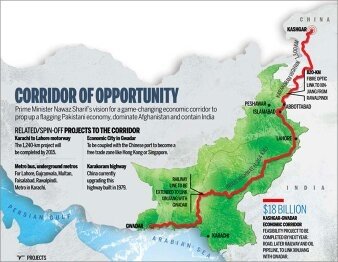Syeda Mazhar
It is no secret that Pak-China bilateral relations have been strong since the beginning – celebrated friendship between the two neighbors, have benefitted both immensely on various fronts. Not only have Pakistan found an ally in China, but also a fitting partner in its socio-economic and political pursuits.
The cornerstones of China-Pakistan relations are equality, sincerity, mutual benefits, mutual assistance, people-orientation and shared prosperity. Bilateral cooperation in the fields of politics, economy, culture, security, and people-to-people exchanges as well as international and regional affairs constiture the pillars of the all-round cooperation between our two countries. The relations have become the model of the state-to-state relations of different civilizations and social systems.
The latest megaproject between Pakistan and China is the one being continuously talked about. Pak-China economic corridor will help to connect the port city Gwadar to the Chinese region Xinjiang. This project aims to help to strengthen the relationship between two countries and will also bring prosperity to the region. Pakistan has been in constant attack from certain terrorist elements and such initiatives will help the country to start its journey towards stability. This megaproject will be of 3000 KM and both countries will be connected through highways, railways and pipelines.
Divided into different phases and the first phase of the project is the completion of Gwadar International Airport and the development of Gwadar Port. The Chinese company will complete the first phase by the year 2017. Other small projects in the Economic corridor include the expansion of Karakoram Highway. This is the road that connects China with Pakistan. A fiber-optic line will also be placed in between the two countries to ensure better communication.
Not merely a road or rail track; the economic corridor is to ensure peace and stability in the region. Pakistan; as being one the major countries in south east Asia can benefit a lot form this project as it will help the country to eliminate the energy crisis and other transportation problems. China; on the other hand will also gain a lot of benefit from this project. This is one the main reasons that they are investing more than 46 million dollars in a foreign land.
According to sources; this is the biggest investment in a foreign land by China. Energy is one of the main problems of China. China is one of the major oil importers in the world and with this economic corridor; they will have a route for safe and sustain energy through pipelines.
CPEC is rewriting the economic geography, and regional integrity of the subcontinent will effectively end the hegemony of India in the region. Bulk of global population live in the northern hemisphere and trade has tended to seek a route to the sea that up till now has not been directly available to most through a single country.
India is taken aback by this project in particular for it was routing on the prediction that as India’s economy grew, Pakistan would be compelled by business and commercial logic to engage with India and becomes dependent on India for its economic prosperity.
The CPEC alters that supposition. It replaces Pakistan’s dependence on a north-south trade corridor with its bet on an east-west corridor, from Kashghar (Xinjiang province) to Gwadar. This trade route is fairly unprecedented and is an expression of a new economic and strategic geography that China wants to define.
The Indian media that had been urging its government to take every step to stop CPEC now clearly stands divided. The saner elements have been urging their government to accept the reality and try to gain trade access through this route.
The hawks however, are still not giving up and have asked their government to disregard international law and stop water channels going to Pakistan through its territory. India tried to align Afghanistan and Iran to develop an alternate route to CPEC by developing the Iranian port of Chabahar. However, it was reluctant to provide the promised assistance for the development of that port.
Iranians also realized that the alternate seaport was viable only if the CPEC was not built. The Indians assured them that they would sabotage the entire route. Alternate trade route through Chahbahar is relatively cheaper than trading goods meant for western China through Shanghai port.
However, if CPEC is operational, the route would be twice as expensive then Gwadar. The Iranians have now informed Pakistan that they are ready to link Chahbahar with CPEC that passes through Pakistan.
Recently, trial run of the China-Pakistan Economic Corridor route successfully from Kashghar to Gwadar has shattered India’s long term plan to squeeze its neighbour economically as the route has provided Islamabad the opportunity to reach lucrative markets at low cost. Following the inauguration, the port has formally been operationalized for trade activities through the western route of CPEC. First mega pilot trade cargo will depart from Gwadar port today for Middle East and African countries.
Speaking on the occasion, Chief Minister Balochistan Sanaullah Zehri welcomed the Chinese mega trade convoy and termed it a landmark in implementing the grand China Pakistan Economic Corridor project.
Chinese Ambassador to Pakistan Sun Weidong said the day is very significant for CPEC and to China Pakistan relations. He said it is for the first time that a convoy successfully passed through the western part of Pakistan from north to the South.
The inauguration of the successful opening of the CPEC has made Pakistan’s geo-political position even stronger and promises to boost the nation’s economy. It is a project for the entire Pakistan and not just for one province. Pakistan pushes forward the infrastructure and connectivity projects on the basis of “one corridor, multiple passages”, so as to bring tangible benefits to both the countries as well as the region.




